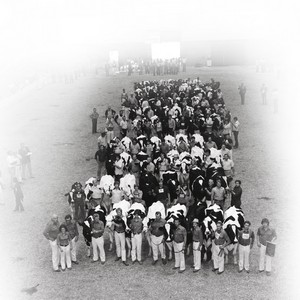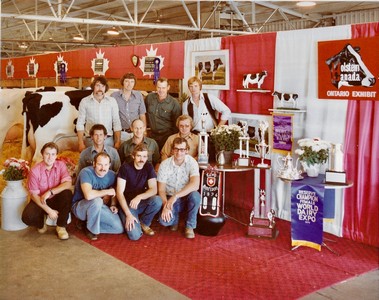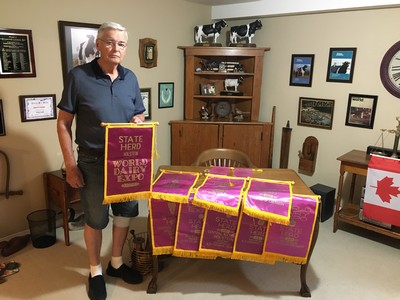This article written by Bonnie Cooper, was featured in our 2019 Fall issue.
For show enthusiasts, the lead-out era of the State Herd class at World Dairy Expo’s Holstein Show in Madison, Wisconsin, remains one of the event’s most cherished memories. For the first 27 years of Expo’s 52-year history, 1967 through 1993, the lead-out class was the exciting climax of the Holstein Show, with sometimes more than a dozen entries filling the ring.

In 1976, a group of showmen from Ontario, dressed in distinctive bright ‘red shirts’, took first place in the State Herd class. It would be the first of 20 State Herd victories for the exhibitors from this Canadian province. Ontario won the State Herd class 14 times when it was a lead-out event (1976-80-81-82-83-84-85-86-87-88-89-91-92-93). They have won it six more times (1994 through 1999) since it became a non-lead-out competition and the winner was determined by a points system.
World Dairy Expo made its debut in 1967. The first Holstein showstrings from Ontario began going to Expo in 1968, with Agro Bros. and R.J. Stewart among the initial exhibitors. Canadian Ray Brubacher, who had been herd manager at Lakeside Farms in Wisconsin from 1953-67 and then returned to Canada to become part of the Brubacher Bros. Ltd. auction sales business, was at those first two shows. Lowell Lindsay of Ariss, ON, now retired sire analyst for Semex, was an AI technician at the time. He well recalls Brubacher telling he and others after the 1968 show, “Boys, you got to go to Madison. This is going to be a great show!” In 1969, Brubacher and Lindsay travelled to Expo together on a county Holstein club plane trip. Lindsay met many people at Madison. He returned to Expo the following year and has attended Expo every year since. Positive reports from Lindsay and others about those early Expos, and the success of Canadian AI unit bull daughters in the shows, soon prompted Canadian AI companies to start having booths at Expo in the 1970s.

While a few more Ontario Holstein breeders were showing at Expo by the early 1970s, Lowell Lindsay realized that many more exhibitors ‘were missing the boat’ by not being there. Many American showmen knew about the good show cattle to be found in Ontario and had already travelled to the province to buy animals for their showstrings. Feeling Ontario cattle could be pretty successful in their own right if they went to Madison, Lowell Lindsay, James A. ‘Jim’ Walker of Walkerbrae Farms, Guelph, ON, West-Central Ontario Holstein Fieldman Joe Snyder (later Ontario Holstein Branch Secretary-Manager from 1980-93), and then Holstein Canada Promotions Manager Jane Whaley put the wheels in motion to formally organize a group of Ontario breeders to go together to World Dairy Expo in 1976. It would mark the first time that a large delegation of Ontario cattle had gone and tied together in Madison.
It took a ‘team effort’ to put those initial Ontario groups and State Herds together stress Lindsay and Walker. While it was an Ontario project, the effort was fully supported by Holstein Canada. Lindsay and Walker talked to breeders about the value of sending their animals to Madison and did the advance checking and selection of the animals who would be part of the exhibit. Whaley handled many of the administrative duties and organized the trucks for the first trip. “The guys kept telling me ‘Don’t get pots. We don’t want pots.’ I didn’t have a clue what they meant, but I figured it out,” laughs Whaley now. Joe Snyder, and his successor Bill Dobbin, lent valuable support in looking after many details and ensuring the exhibits secured financial grants and assistance to help with expenses and pay for the reception/party held after the show. As Whaley says, “We were all writing the playbook because this had never been done before as a group. We were writing the playbook for the future and that is why it kept getting better and better.”
“We loaded the cattle at the Brubacher Sale Arena in Guelph that first year,” recalls Walker. Once in Madison, the Ontario cattle tied together in one of the front barns on the Expo grounds. They didn’t take much in the way of decorations and had to figure out where and how to rent tables and plants for the booth. When the weather turned hot, they had to go out and buy fans for the cows. They all worked together as one.
Jim Walker oversaw the Ontario exhibit and the fitters that had been hired by the Branch to prepare and look after the cattle. There were a lot of young men who got their start with the Ontario exhibit and many went on to become well-known professional fitters.
The Ontario cattle realized immense success that year, capturing several first place ribbons and champion rosettes. “Our main goal of going to Madison was never the State Herd,” says Lindsay. “It was simply to get a few cattle there. But along the line it evolved to the fact that if we could get enough people to go, and we did well enough, we could have a State Herd. And then if we had a State Herd we decided we needed to do something different. That is where the ‘red shirt’ idea started.”
“I found the red shirts at a Zellers store in Hamilton,” says Whaley. “I called Lowell and he came down and looked at them. We bought all we could get but still needed more.” Lindsay continues, “I had to run around to at least four or five more Zellers stores in places like Orangeville, Kitchener and Stoney Creek to get the rest. We wanted to keep this thing quiet. Where the cattle come into the Coliseum at Expo there is a big dressing room around the corner to the right. It was not until the State Herds were assembling to go into the ring that the red shirts came out. Then the people who had been selected to lead out the Ontario herd changed and were put into the red shirts. The shirts were never seen on the grounds or in the individual classes before that.”

Ontario captured first place in the State Herd class that year. The Holstein Journal wrote, “All outfitted in bright red shirts, the Ontario showmen were an impressive sight as they moved to the top of the State Herd class, while the strains of ‘O Canada’ played in the background.” Headlining that group were the trio of cows who had finished one-two-three in the mature cows. Winning that class, and becoming Canada’s first Grand Champion Holstein female and Supreme Champion at Expo, was Theynor Hagen Cindy from T. Robert Flett. Winchester Marquis Topsy, who was the show’s Reserve Grand Champion for Rowntree Farms, placed second, while in third was Spring Farm Citation Rosetta from Spring Farms.
Ontario’s red shirts became a trademark during the State Herd lead-out years. Only once did a ‘pink’ shirt make its way into the Ontario line-up. As the story goes, R. Peter Heffering of Hanover Hill Holsteins wore a red shirt in 1976, but the shirt didn’t fit properly and he swore never to wear it again. When Ontario won the State Herd class in 1980, Heffering took some good-natured ribbed for the ‘pink’ shirt he was pictured in. A trip to a ‘Big and Tall’ men’s clothing store in Toronto by Holstein Journal Editor Bonnie Cooper ensured that Heffering was back in ‘red’ when Ontario headed the State Herd class in 1981. In the years to come, American states adopted the colored shirt concept as well for their State Herds.
After a couple years, the Ontario exhibitors were moved to barns at the back of the fairgrounds where they were housed in a half barn and a long crossways barn called Barn L. Barn L quickly became known as the ‘Canadian Barn’ and was a popular destination for Expo visitors and other exhibitors. “When we arrived in Madison, the Americans were right there to see what the Canadians had brought for the Ontario State Herd,” recalls Lindsay. As Jim Walker’s oldest son Brent adds, “It got so that other American exhibitors liked to tie in the Canadian barn because there was a lot of traffic in that barn.”
As Ontario Holstein exhibitors began taking more showstrings of their own to Madison, the Ontario group exhibit was eventually phased out. Even when the Ontario cattle were not in one group, Lowell Lindsay, Jim Walker and Joe Snyder/Bill Dobbin continued to draw up the final list of animals that would make up the Ontario State Herd entry. A State Herd consists of eight animals: three cows, three heifers, and two animals of any age. Animals must be housed in the state or province for which they are being entered, and owned by not less than three exhibitors, with no exhibitor furnishing more than three animals. Holstein Canada gave a $1000 grant to the provinces that showed a State Herd during the lead-out years and provided other financial assistance to help offset exhibitors’ expenses. “There was always a lot of jockeying as to who would fit and who was eligible for the State Herds as a result of the rules,” says Lindsay. In addition to utilizing high placing animals, the ‘uniformity’ of the group was also very important during those lead-out years. “At Canadian judging schools we always talked about the importance of uniformity when judging groups,” says Lindsay, “and there were times when we didn’t use a prize winner in the State Herd for the sake of uniformity.”
The power, quality and uniformity of those Ontario lead-out herds always made them a formidable competitor. “The quality of the cattle, and the professionalism of the leadsmen, gave them such a ‘presence’ in the ring and made them a sight to behold,” says Jane Whaley.

A long list of great cows and heifers appeared in those winning lead-out Ontario State Herds. The most famous was Brookview Tony Charity, Expo’s only four-time Supreme Champion. This American bred, but Canadian owned cow anchored the winning Ontario State Herds in 1982, 1984, 1985 and 1987 when she was Grand Champion at Madison. Other Expo Grand Champions to put Ontario at the top of the lead-out State Herd classes were J-WS Monitor Racheal in 1981 and Cathland Lilac in 1988, and Reserve Grand Champions JPG Standout Kandy in 1981, Racheal in 1982, Du-Ma-Ti Valiant Boots Jewel in 1988, Don-A-Dale Jet Crystal in 1989 and 1991, Browndale C M Reta in 1992, and Dupasquier Starb Winnie in 1993 (Winnie was also grand in 1994, a non-lead-out year). Other prominent females known to be part of those first prize herds include Chancel, Sterling Silver, Charleen, Ulti Cheryl, Countess, Doris, Tony Sadie, FM T T Marq I, Star Lulu, Astro Anna, Monalisa, Pre Vicky, Lancer Bunny, Christy Com, Star Missy, Christopher Jacki, Rose Blossom and many more.
The success of the Ontario State Herds did not go unnoticed. “As the years went on people across Canada became much more aware of what the Ontario State Herds had accomplished and how much benefit it was,” says Lindsay. “People started asking ‘Are you going to Madison?’ ‘What about this Madison Show?’ We saw more and more Canadian people make the trip every year to Expo.” As Whaley states, “Everyone was going down just to see how well the Canadians would do. We were so proud as Canadians of this Ontario group. All of Canada embraced these guys in Madison, just like the Toronto Raptors basketball team was embraced by all of Canada this spring.”
While Ontario’s Expo achievements were a great promotion for ‘Ontario’ cattle, it soon became evident that their presence signified something far greater…they were representing ‘Canada’ and ‘Canadian Holsteins’. As Lowell Lindsay says, “People began to realize that the guys from Ontario were doing a great job and they became more appreciative that this project was really about promoting ‘Canadian’ Holsteins.” That ‘Canadian’ presence was further bolstered when Holstein breeders from Alberta started exhibiting at Expo in 1980, followed by Quebec in 1982, and then the Atlantic and other Western Canada provinces in the 1990s.
Showing at Expo has been a great marketing tool for Canadians and Canadian Holsteins says Lindsay. “There are many Canadian breeders who have sold embryos and cattle as a result of the connections and people they have met from the United States and other foreign countries while showing animals at Madison. It has also been a huge boost for Canadian AI units and their products.” Brent Walker agrees. “Because of our State Herd success, more Americans came to Canada to buy a show heifer or cow. It brought buyers to our spring sales. It helped a lot of breeders market animals who didn’t even go to Madison.”
Canadian Holstein breeders are very appreciative of the opportunity they have had to exhibit at World Dairy Expo. They are grateful for the many lifelong business and personal relationships they have developed with American showmen because of their Expo participation. As Lowell Lindsay points out, “While we are very proud to have won those State Herd classes, we are also very aware of the fact that we are guests at World Dairy Expo. We are very fortunate to be able to bring our cattle to Madison, exhibit them, and be recognized for that. Expo, with the exception of a few years, draws participants from Canada and the United States, and sometimes owners from other countries who have partnerships in cattle. The show has evolved into not only the best of Canada and the United States, but the best of the world. Today World Dairy Expo is a family.”





